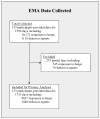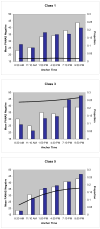Daily mood patterns and bulimic behaviors in the natural environment
- PMID: 19152874
- PMCID: PMC2656423
- DOI: 10.1016/j.brat.2008.11.006
Daily mood patterns and bulimic behaviors in the natural environment
Abstract
Objective: Negative affect has been purported to play an important role in the etiology and maintenance of bulimic behaviors. The objective of this study was to identify daily mood patterns in the natural environment exhibited by individuals with bulimia nervosa and to examine the relationship between these patterns and bulimic behaviors.
Method: One hundred thirty-three women aged 18-55 meeting DSM-IV criteria for bulimia nervosa were recruited through clinical referrals and community advertisements. Ecological momentary assessment was used to collect multiple ratings of negative affect, binge eating and purging each day for a two-week period using palmtop computers. Latent growth mixture modeling was used to identify daily mood patterns.
Results: Nine distinct daily mood patterns were identified. The highest rates of binge eating and purging episodes occurred on days characterized by stable high negative affect or increasing negative affect over the course of the day.
Conclusions: These findings support the conclusion that negative mood states are intimately tied to bulimic behaviors and may in fact precipitate such behavior.
Figures




Similar articles
-
Reciprocal associations between negative affect, binge eating, and purging in the natural environment in women with bulimia nervosa.J Abnorm Psychol. 2016 Apr;125(3):381-6. doi: 10.1037/abn0000135. Epub 2015 Dec 21. J Abnorm Psychol. 2016. PMID: 26692122 Free PMC article.
-
Temporal associations between affective instability and dysregulated eating behavior in bulimia nervosa.J Psychiatr Res. 2017 Sep;92:183-190. doi: 10.1016/j.jpsychires.2017.04.009. Epub 2017 Apr 26. J Psychiatr Res. 2017. PMID: 28482293 Free PMC article.
-
Ecological momentary assessment of stressful events and negative affect in bulimia nervosa.J Consult Clin Psychol. 2014 Feb;82(1):30-9. doi: 10.1037/a0034974. Epub 2013 Nov 11. J Consult Clin Psychol. 2014. PMID: 24219182 Free PMC article.
-
Two pathways toward impulsive action: an integrative risk model for bulimic behavior in youth.J Child Psychol Psychiatry. 2014 Aug;55(8):852-64. doi: 10.1111/jcpp.12214. Epub 2014 Feb 21. J Child Psychol Psychiatry. 2014. PMID: 24673546 Free PMC article. Review.
-
Frequency of binge eating episodes in bulimia nervosa and binge eating disorder: Diagnostic considerations.Int J Eat Disord. 2009 Nov;42(7):603-10. doi: 10.1002/eat.20726. Int J Eat Disord. 2009. PMID: 19610014 Free PMC article. Review.
Cited by
-
Cannabis use during a voluntary quit attempt: an analysis from ecological momentary assessment.Drug Alcohol Depend. 2013 Oct 1;132(3):610-6. doi: 10.1016/j.drugalcdep.2013.04.013. Epub 2013 May 7. Drug Alcohol Depend. 2013. PMID: 23664121 Free PMC article. Clinical Trial.
-
Relationship between daily affect and overeating-only, loss of control eating-only, and binge eating episodes in obese adults.Psychiatry Res. 2014 Jan 30;215(1):185-91. doi: 10.1016/j.psychres.2013.08.023. Epub 2013 Nov 5. Psychiatry Res. 2014. PMID: 24200217 Free PMC article.
-
The potential of calibrated fMRI in the understanding of stress in eating disorders.Neurobiol Stress. 2018 Aug 18;9:64-73. doi: 10.1016/j.ynstr.2018.08.006. eCollection 2018 Nov. Neurobiol Stress. 2018. PMID: 30450374 Free PMC article. Review.
-
Poisson Growth Mixture Modeling of Intensive Longitudinal Data: An Application to Smoking Cessation Behavior.Struct Equ Modeling. 2012 Jan;19(1):65-85. doi: 10.1080/10705511.2012.634722. Struct Equ Modeling. 2012. PMID: 22408365 Free PMC article.
-
Momentary emotion surrounding bulimic behaviors in women with bulimia nervosa and borderline personality disorder.J Psychiatr Res. 2012 Nov;46(11):1492-500. doi: 10.1016/j.jpsychires.2012.08.014. Epub 2012 Sep 7. J Psychiatr Res. 2012. PMID: 22959165 Free PMC article.
References
-
- Akaike H. Factor analysis and AIC. Psychometrika. 1987;52:317–332.
-
- American Psychiatric Association (APA) Diagnostic and statistical manual of mental disorders. 4. Washington, DC: American Psychiatric Association; 1994.
-
- Bozdogman H. Model selection and Akaike’s information criterion: The general theory and its analytical extensions. Psychometrika. 1987;52:345–370.
-
- Cooley E, Toray T. Body image and personality predictors of eating disorder symptoms during the college years. International Journal of Eating Disorders. 2001;30(1):28–36. - PubMed
Publication types
MeSH terms
Grants and funding
LinkOut - more resources
Full Text Sources

